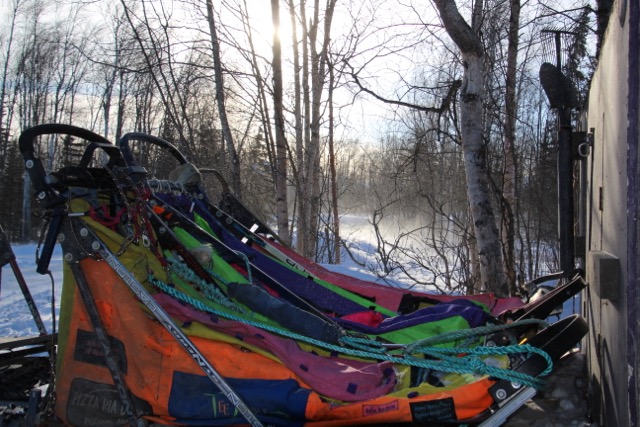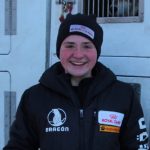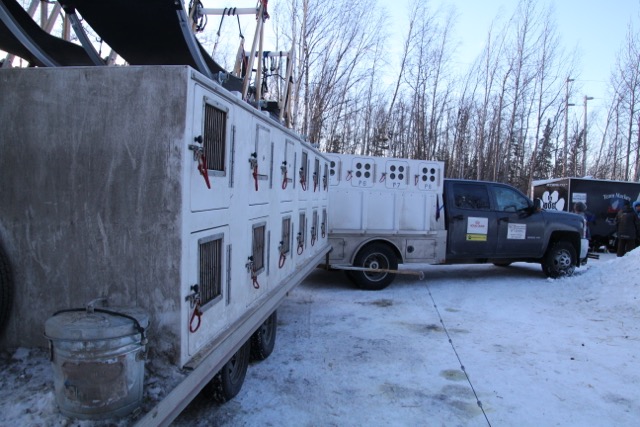Observing the triad of interaction between mushers, canine athletes and veterinarians was the objective for the teacher’s field trip to Vet Check at Iditarod Headquarters. Sled dogs have remarkable physiological properties that make them the envy of human athletes. The sled dog is often described as indomitable and revered for its spirit, courage, strength, determination and faith. With a well-planned run, rest and feeding schedule the sled dog can go hour after hour and day after day. By the time a team finishes Iditarod, the dogs will have travelled the distance of forty marathons.
The weather in Wasilla was a bonus learning experience for the teachers from the lower 48. The temperature was 10 degrees with bright sun. It was the wind, sustained at 27 mph and gusting to 57 mph, that gave everyone something to think and talk about. The wind chill ranged from minus 11 to minus 18 degrees. Snow was blowing, visibility was reduced and the tiny snow pellets stung as they hit one’s face. It was even hard to walk in a straight line. Don’t quite know how we could have been so lucky as to have those winds to allow the teachers a little taste of what the mushers experience on the top of Rainy Pass, out in Unalakleet, in Shaktoolik and at the blow hole between White Mountain and Nome.
The veterinary team works with mushers and dogs before, during and after the race. The team consists of 45-50 veterinarians. All vets are certified by the International Sled Dog Veterinarian Medical Association (ISDVMA). There’s also a large team of Veterinary Technicians working with the mushers and athletes. Pre-race screenings include an EKG, complete blood counts and chemical panels. The dogs are all micro chipped and dewormed. On the day of Vet check, the teachers observed the veterinarians in action with the pre-race physicals.
- Veteran Al Eischens
- Rookie Laura Neese
- Rookie Ryan Anderson
While at Vet Check, the teachers met mushers Charley Bejna, Jason Mackey, Laura Neese, Dr, Joe Carson, Ryan Anderson, Matthew Failor, Karin Hendrickson, Ellen Halverson, Al Eischens, Joar Leifseth Ulsom and Trent Herbst. Some of the dog transport vehicles and trailers are incredibly elaborate while others are very basic. The Nature’s Kennel mushers from the Upper Peninsula of Michigan travelled some 3,500 miles to arrive at vet check. Take a look at their rig.
Traveling via the mobile learning center north on the Park’s Highway, we found our way to Matthew Failor’s 17th Dog Kennel. Matthew, who had just returned from Vet Check, introduced the teachers to his canine athletes. Rookie Michael Baker will be running out of 17th Dog along with Matthew. Failor’s kennel has a large number of yearling dogs who are trail ready for Iditarod. They’ll be split evenly between the two mushers and for just a little insurance, a few older more experienced dogs will be on each team of sixteen. Failor and Baker will be schooling the young dogs in camping, the trail and checkpoint routine. By the time the young dogs reach Nome, they will have progressed from kindergarten to post high school and be candidates for the 17th Dog “B” teams for 2018.
Failor and Baker schooled the teachers on gear, dog care and nutrition. Back out in the dog yard, Failor and Baker harnessed dogs and hooked a team of eight up to the gangline for a short run. During the harnessing and hookup, it was just like a class of enthusiastic students. The dogs were barking as if to yell out, “Pick me!” The dogs were leaping and jumping as if to say, “Pick me, I have lots of energy.” Dog’s tails were high and wagging and their ears were standing at attention as if to say, “Pick me, I’m ready and WANT to run.” Well the eight dogs that were hooked up had been predetermined based on who had run the day before. The dogs were so excited at the prospect of running, the noise of the dog yard could only be described as excited pandemonium. Then as the small team cruised out of the dog yard and down the trail, the dogs that remained in the yard turned quiet. If one could read the minds of the dogs not chosen for this run, they’d be thinking, “I know he’ll choose me for the next run.”
In addition to the visits at Vet Check and 17th Dog Kennel, teachers also viewed video presentations, “Why They Run” and “Iditarod National Historic Trail – a History” while traveling in the Mobile learning center.
The day was on sight experiential learning at it’s best. Teacher’s returned to the “official” conference center in Anchorage with much information for their sled bags and many new ideas for using the theme of Iditarod to motivate students.







































